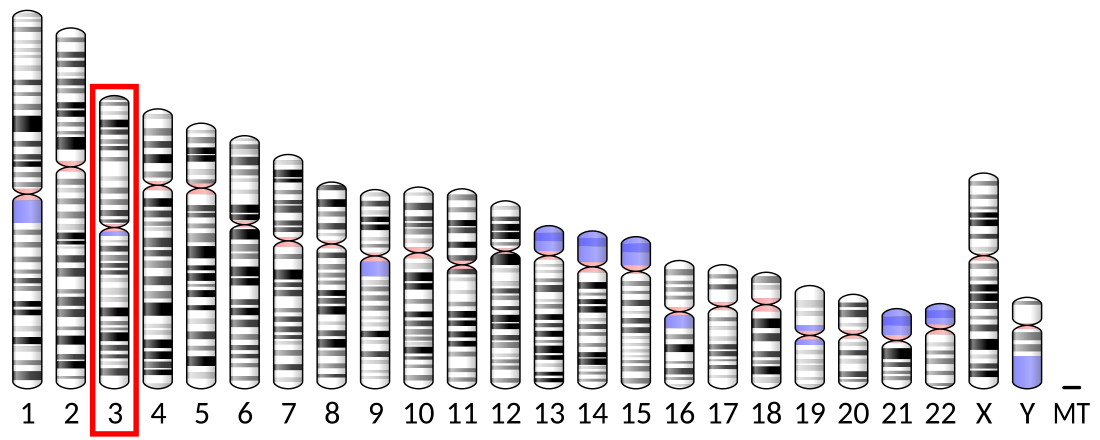Metabotropic glutamate receptor 2
Mammalian protein found in humans From Wikipedia, the free encyclopedia
Metabotropic glutamate receptor 2 (mGluR2) is a protein that, in humans, is encoded by the GRM2 gene.[5][6] mGluR2 is a G protein-coupled receptor (GPCR) that couples with the Gi alpha subunit.[7] The receptor functions as an autoreceptor for glutamate, that upon activation, inhibits the emptying of vesicular contents at the presynaptic terminal of glutamatergic neurons.
Structure
In humans, mGluR2 is encoded by the GRM2 gene on chromosome 3. At least three protein-coding isoforms are predicted based on genomic information, as well as numerous non-coding isoforms. The mGluR2 protein is a seven-pass transmembrane protein.
Function
In humans, mGluR2 is only expressed in the brain, and not in any other tissue.[8] In the brain, mGluR2 is expressed in neurons as well as astrocytes. Subcellularly, mGluR2 is predominantly positioned at the presynaptic terminal, although it is also expressed at the postsynaptic terminal.[9]
The metabotropic glutamate receptors are a family of G protein-coupled receptors, that have been divided into 3 groups on the basis of sequence homology, putative signal transduction mechanisms, and pharmacologic properties: Group I includes GRM1 and GRM5 and these receptors have been shown to activate phospholipase C. Group II includes mGluR2 (this receptor) and GRM3 while Group III includes GRM4, GRM6, GRM7 and GRM8. Group II and III receptors are linked to the inhibition of the cyclic AMP cascade but differ in their agonist selectivities.[6]
Protein–protein interactions
mGluR2 is able to form a heteromeric complex with various other different GPCRs. One example is with isoform mGluR4. The mGluR2-mGluR4 heteromer exhibits a pharmacological profile distinct from the parent receptor monomers.[10] Another example is with serotonin receptor 2A (5HT2A); see below.
Pharmacology
Summarize
Perspective
The development of subtype-2-selective positive allosteric modulators (PAMs) experienced steady advance in recent years.[11] mGluR2 potentiation is a new approach for the treatment of schizophrenia.[12][13] On the other hand, antagonists and negative allosteric modulators of mGluR2/3 have potential as antidepressant drugs.[14][15][16][17][18]
Agonists
PAMs

- JNJ-46356479[22]
- JNJ-40411813[23]
- GSK-1331258[24]
- Imidazo[1,2-a]pyridines[25]
- 3-Aryl-5-phenoxymethyl-1,3-oxazolidin-2-ones[26]
- 3-(Imidazolyl methyl)-3-aza-bicyclo[3.1.0]hexan-6-yl)methyl ethers: potent, orally stable[27]
- BINA:[28][29] potent; modest ago-allosteric modulator; robust in-vivo activity.
- LY-487,379:[30][31][32] devoid of orthosteric activity; along with related 3-pyridylmethylsulfonamides[33][34] the first subtype-2-selective potentiator published (2003).
Antagonists
NAMs
- 7,8-dichloro-4-[3-(2-methylpyridin-4-yl)phenyl]-1,3-dihydro-1,5-benzodiazepin-2-one and related compounds.[35]
- MNI-137 - 8-bromo-4-(2-cyanopyridin-4-yl)-1H-benzo[b][1,4]diazepin-2(3H)-one[36]
- RO4491533 - 4-[3-(2,6-dimethylpyridin-4-yl)phenyl]-7-methyl-8-trifluoromethyl-1,3-dihydrobenzo[b][1,4]diazepin-2-one[37]
Role in hallucinogenesis
Many psychedelic drugs (e.g. LSD-25) produce their effects by binding to the oligomerized complexes of the 5HT2A and mGlu2 receptors.[38][39] Lisuride acts preferentially or exclusively on the non-heteromerized 5HT2A receptors, which are not capable of inducing psychedelic effects. Due to this, lisuride is capable of reducing the hallucinogenic effects of these drugs through competitive antagonistic activity (producing the effect of a silent antagonist in the presence of these drugs).
Strong agonists for either subunit of the 5HT2A-mGlu2R heterocomplex suppress signaling through the partner subunit and inverse agonists for either subunit potentiate the signaling through the partner subunit.
Role in rabies virus infection
mGluR2 has been found to be a novel receptor for rabies virus.[40] The virus has a glycoprotein on its surface which interacts with the receptor. Rabies virus can bind to mGLuR2 directly and the virus-receptor complex is internalized into the cell together. The complex is then transported into early and late endosomes. Rabies virus enters the cells by clathrin-independent endocytosis which could suggest that mGLuR2 also uses this pathway. It is still to be clarified whether the Rabies virus glycoprotein can act as a PAM or NAM and in such a way affect the function of the receptor.
See also
References
External links
Wikiwand - on
Seamless Wikipedia browsing. On steroids.





